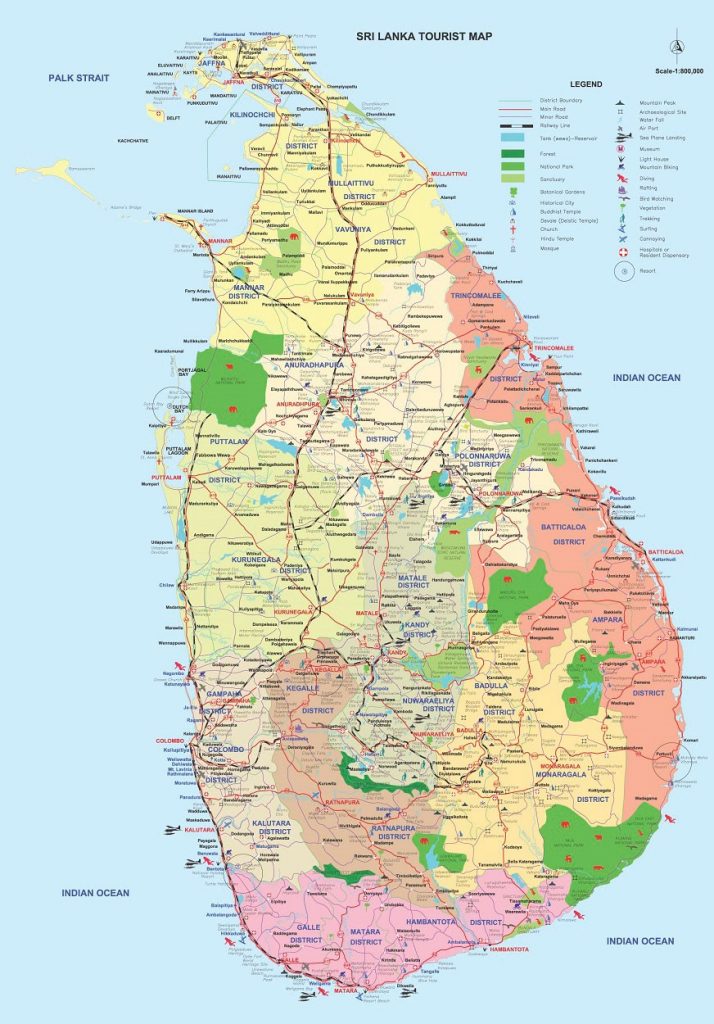
Known as Serendib, Taprobane, the pearl of the Indian Ocean, and Ceylon, Sri Lanka offers a diversity of attractions to suit each visitor's individual taste, be it nature, history, culture, adventure or golden beaches.
Within a mere area of 65,610 kilometres lie 8 UNESCO World Heritage Sites, 330 kilometres of coastline - much of it pristine beach - 15 national parks showcasing an abundance of wildlife, nearly 500,000 acres of lush tea estates, 250 acres of botanical gardens, 350 waterfalls, 25,000 water bodies, to a culture that extends back to over 2,500 years.
|
Official name: |
Democratic Socialist Republic of Sri Lanka |
|
Government type: |
Republic |
|
Location: |
Latitude 5° 55. to 9° 50. north, longitude 79° 42. to 81° 52., 650 km north of the equator |
|
Dimensions: |
430 km north to south, 225 km east to west |
|
Coastline: |
1,340 km |
|
Area: |
65,525 km |
|
Currency (code): |
Sri Lankan rupee (LKR) |
|
Independence: |
4 February 1948 |
|
Administrative capital: |
Sri Jayewardenapura |
|
Commercial capital: |
Colombo |
|
Administrative divisions: |
9 provinces; Central, North Central, North Eastern, North Western, Sabaragamuwa, Southern, Uva, Western, Eastern Province |
|
Climate: |
Tropical, with a northeast monsoon (December to March) bringing unsettled weather to the north and east, and a southwest monsoon (June to October) bringing bad weather to the south and west |
|
Terrain: |
Mostly low, flat to rolling plain; mountains in south-central interior |
|
Highest mountain: |
Pidurutalagala, 2,524m |
|
Highest waterfall: |
Bambarakanda, 263m |
|
National Flower |
The Blue Water Lily (Nymphaea stellata) |
|
National parks and nature reserves area: |
8,000sq.km |
|
Population: (Mid year 2021) |
22,156,000 |
|
Population growth rate: (2021) |
1.1% |
|
Population Density: |
353 people per sq km |
|
Life Expectancy at Birth |
Female 80, Male 77 |
|
Literacy rate : |
Female 92.2% Male 93.8% |
|
Ethnic groups: |
Sinhalese 74.9%, Sri Lankan Moors 9.2%, Indian Tamil 4.2%, Sri Lankan Tamil 11.2%, other 0.5%, (2012 census) |
|
Languages: |
Sinhala (official and national language) 87%, Tamil (official and national language) 28.5%, English 23.8% (2012 est.) Note: English (a link language commonly) is used in government and spoken competently by 23.8% of the population |
|
Religion: |
Buddhist (official) 70.2%, Hindu 12.6%, Muslim 9.7%, Roman Catholic 6.1%, other Christian 1.3%, other 0.05% (2012 est.) |
|
Time zone: |
Sri Lanka Standard Time is five and a half hours ahead of GMT. (Allowance should be made for summer-time changes in Europe) |
|
International dialing: |
+94 |
|
Electricity: |
230- 240 volts, 50 cycles AC. If you travel with a laptop computer bring a stabilizer |
|
Economy: |
Sri Lankan economy recorded a growth of 3.7 per cent in 2021, in real terms, compared to the contraction of 3.6 per cent recorded in the preceding year. All sectors of the economy registered growth during the year, agriculture, forestry and fishing by 2.0 per cent; industry by 5.3 per cent; and services by 3.0 per cent. Sri Lanka’s most dynamic sectors are food processing, textiles and apparel, food and beverages, Information Technology/ Business Process Outsourcing (IT/ BPO) sector, port construction, telecommunications, and insurance and banking. |
|
Labour force |
27.3% of the labour population is employed in agriculture, 26% in industry and 46.7 % in services: (2021) The unemployment rate is 5.1% (2021) Sri Lanka has seen a tenfold increase in migrant numbers in the last two decades, and current estimates suggest that about 1.7 million migrants work abroad, with an annual outflow of about 200,000 persons. |
|
Agriculture & products |
rice, coconuts, sugar cane, plantains, milk, tea, cassava, maize, poultry, coir |
|
Industries: |
processing of rubber, tea, coconuts, tobacco and other agricultural commodities; telecommunications, insurance, banking; tourism, shipping; clothing, textiles; cement, petroleum refining, information technology services, construction |
|
Exports: |
Apparel & Textiles, Boat and Ship Building, Ceylon Tea, Coconut & Coconut based Products, Diamonds, Gems & Jewellery, Food, Feed & Beverages, Rubber & Rubber Based Products, Spices, Essential Oils & Oleoresins. Main Export partners are United States of America 25%, United Kingdom 7.6%, India 6.7%, Germany 6%, Italy 4.7% (2021) |
|
Imports: |
Main import commodities are textile fabrics, mineral products, petroleum, foodstuffs, machinery and transportation equipment etc. Main import partners are China 24%, India 22%, United Arab Emirates 6.5% Malaysia 4%, Singapore 3.6% (2021) |
|
Gross Domestic Product (GDP): |
GDP at constant prices grew by 3.7 per cent to Rs. 9,881.4 billion in 2021, compared to 3.6 per cent contraction recorded in 2020. Meanwhile, GDP at current prices was estimated at Rs. 16,809.3 billion (US dollars 84.5 billion in 2021, recording a notable increase of 11.9 per cent compared to 2020, where it stood at Rs. 15,027.4 billion (US dollars 81.0 billion). GDP per capita increased to Rs. 758,680 (US dollars 3,815) in 2021, compared to Rs. 685,587 (US dollars 3,695) in 2020. |
|
Gross National Income (GNI): |
GNI, which is estimated by adjusting GDP for the net primary income from the rest of the world, recorded a growth of 12.3 per cent at current prices in 2021, compared to the marginal growth of 0.3 per cent recorded in 2020. This growth in GNI was largely due to the decline in negative balance of net primary income on top of the significant increase in GDP at current prices in 2021, compared to last year. |
|
National Flag
|
The national flag was hoisted for the first time on March 3, 1950. Its design was approved in February 1950 by a committee appointed by the first Prime Minister of independent Sri Lanka, D. S. Senanayake |